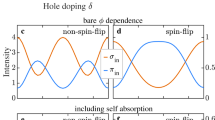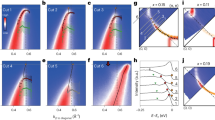Abstract
Theories involving highly energetic spin fluctuations are among the leading contenders for explaining high-temperature superconductivity in the cuprates1. These theories could be tested by inelastic neutron scattering (INS), as a change in the magnetic scattering intensity that marks the entry into the superconducting state provides a precise quantitative measure of the spin-interaction energy involved in the superconductivity2,3,4,5,6,7,8,9,10,11. However, the absolute intensities of spin fluctuations measured in neutron scattering experiments vary widely, and are usually much smaller than expected from fundamental sum rules, resulting in ‘missing’ INS intensity2,3,4,5,12,13. Here, we solve this problem by studying magnetic excitations in the one-dimensional related compound, Sr2CuO3, for which an exact theory of the dynamical spin response has recently been developed. In this case, the missing INS intensity can be unambiguously identified and associated with the strongly covalent nature of magnetic orbitals. We find that whereas the energies of spin excitations in Sr2CuO3 are well described by the nearest-neighbour spin-1/2 Heisenberg Hamiltonian, the corresponding magnetic INS intensities are modified markedly by the strong 2p–3d hybridization of Cu and O states. Hence, the ionic picture of magnetism, where spins reside on the atomic-like 3d orbitals of Cu2+ ions, fails markedly in the cuprates.
This is a preview of subscription content, access via your institution
Access options
Subscribe to this journal
Receive 12 print issues and online access
$259.00 per year
only $21.58 per issue
Buy this article
- Purchase on SpringerLink
- Instant access to full article PDF
Prices may be subject to local taxes which are calculated during checkout




Similar content being viewed by others
References
Eschrig, M. The effect of collective spin-1 excitations on electronic spectra in high-Tc superconductors. Adv. Phys. 55, 47–183 (2006).
Tranquada, J. M. et al. Quantum magnetic excitations from stripes in copper oxide superconductors. Nature 429, 534–538 (2004).
Hayden, S. M., Mook, H. A., Dai, P., Perring, T. G. & Doğan, F. The structure of the high-energy spin excitations in a high-transition-temperature superconductor. Nature 429, 531–534 (2004).
Fong, H. F. et al. Neutron scattering from magnetic excitations in Bi2Sr2CaCu2O8+δ . Nature 398, 588–591 (1999).
Bourges, P., Casalta, H., Ivanov, A. S. & Petitgrand, D. Superexchange coupling and spin susceptibility spectral weight in undoped monolayer cuprates. Phys. Rev. Lett. 79, 4906–4909 (1997).
Coldea, R. et al. Spin waves and electron interactions in La2CuO4 . Phys. Rev. Lett. 86, 5377–5380 (2001).
Dahm, T. et al. Strength of the spin-fluctuation-mediated pairing interaction in a high-temperature superconductor. Nature Phys. 5, 217–221 (2009).
Hinkov, V. et al. Spin dynamics in the pseudogap state of a high-temperature superconductor. Nature Phys. 3, 780–785 (2007).
Woo, H. et al. Magnetic energy change available to superconducting condensation in optimally doped YBa2Cu3O6.95 . Nature Phys. 396, 600–604 (2006).
Demler, E. & Zhang, F.-C. Quantitative test of a microscopic mechanism of high-temperature superconductivity. Nature 396, 733–735 (1998).
Kee, H.-Y., Kivelson, S. A. & Aeppli, G. Spin-1 neutron resonance peak cannot account for electronic anomalies in the cuprate superconductors. Phys. Rev. Lett. 88, 257002 (2002).
Lorenzana, J., Seibold, G. & Coldea, R. Sum rules and missing spectral weight in magnetic neutron scattering in the cuprates. Phys. Rev. B 72, 224511 (2005).
Zaliznyak, I. A. et al. Spinons in the strongly correlated copper oxide chains in SrCuO2 . Phys. Rev. Lett. 93, 087202 (2004).
Anderson, P. W. The resonating valence bond state in La2CuO4 and superconductivity. Science 235, 1196–1198 (1987).
Anderson, P. W. New approach to the theory of superexchange interaction. Phys. Rev. 79, 2–13 (1959).
Pauling, L. The nature of the chemical bond. Application of results obtained from the quantum mechanics and from a theory of paramagnetic susceptibility to the structure of molecules. J. Am. Chem. Soc. 53, 1367–1400 (1931).
Alperin, H. A. Aspherical 3d electron distribution in NI++. Phys. Rev. Lett. 6, 55–57 (1961).
Hubbard, J. & Marshall, W. Covalency effects in neutron diffraction from ferromagnetic and antiferromagnetic salts. Proc. Phys. Soc. 86, 561–572 (1965).
Plakhty, V. P., Gukasov, A. G., Papoular, R. J. & Smirnov, O. P. Spin density on ligands O2− and covalency of Fe3+ ions in octahedral sites of the Ca3Fe2Ge3O12 garnet: A polarised neutron diffraction study. Europhys. Lett. 48, 233–239 (1999).
Zhang, F. C. & Rice, T. M. Effective Hamiltonian for the superconducting Cu oxides. Phys. Rev B 37, 3759–3762 (1988).
Shirane, G., Shapiro, S. M. & Tranquada, J. M. Neutron Scattering with a Triple Axis Spectrometer 35–54, 126 (Cambridge Univ. Press, 2002).
Pickett, W. E. Electronic structure of the high-Tc cuprates. Rev. Mod. Phys. 61, 433–512 (1989).
Ku, W., Rosner, H., Pickett, W. E. & Scalettar, R. T. Insulating ferromagnetism in La4Ba2Cu2O10: An ab initio Wannier function analysis. Phys. Rev. Lett. 89, 167204 (2002).
Neudert, R. et al. Four-band extended Hubbard Hamiltonian for the one-dimensional cuprate Sr2CuO3: Distribution of oxygen holes and its relation to strong intersite Coulomb interaction. Phys. Rev. B 62, 10752–10765 (2000).
Caux, J.-S. & Hagemans, R. The four-spinon dynamical structure factor of the Heisenberg chain. J. Stat. Mech. P12013 (2006).
Suzuura, H., Yasuhara, H., Furusaki, A., Nagaosa, N. & Tokura, Y. Singularities in optical spectra of quantum spin chains. Phys. Rev. Lett. 76, 2579–2582 (1996).
Kojima, K. M. et al. Reduction of ordered moment and Néel temperature of quasi-one-dimensional antiferromagnets Sr2CuO3 and Ca2CuO3 . Phys. Rev. Lett. 78, 1787–1790 (1997).
Fretfolt, T., Shirane, G., Mitsuda, S., Remeika, J. P. & Cooper, A. S. Magnetic form factor in La2CuO4 . Phys. Rev. B 37, 137–142 (1988).
Shamoto, S., Sato, M., Tranquada, J. M., Sternlieb, B. J. & Shirane, G. Neutron-scattering study of antiferromagnetism in YBa2Cu3O6.15 . Phys. Rev. B 48, 13817–13825 (1993).
Kaplan, T. A., Mahanti, S. D. & Chang, H. Spin fluctuations and covalence in the half-filled narrow-band Hubbard model. Phys. Rev. B 45, R2565–R2568 (1992).
Acknowledgements
We acknowledge discussions with J. Tranquada, F. Essler, H. Benthien and D. F. McMorrow. Work at BNL was supported by the Office of Science, US Department of Energy under Contract No. DE-AC02-98CH10886. J.-S.C. acknowledges support from the FOM foundation.
Author information
Authors and Affiliations
Contributions
Project planning: I.A.Z., T.G.P.; sample preparation: G.D.G.; experiments: I.A.Z., T.G.P., A.C.W., A.T.S.; theory: J.S.C., C.C.L., W.K.; data analysis: A.C.W., T.G.P., I.A.Z.; paper writing: I.A.Z., A.C.W.
Corresponding author
Rights and permissions
About this article
Cite this article
Walters, A., Perring, T., Caux, JS. et al. Effect of covalent bonding on magnetism and the missing neutron intensity in copper oxide compounds. Nature Phys 5, 867–872 (2009). https://doi.org/10.1038/nphys1405
Received:
Accepted:
Published:
Issue Date:
DOI: https://doi.org/10.1038/nphys1405



